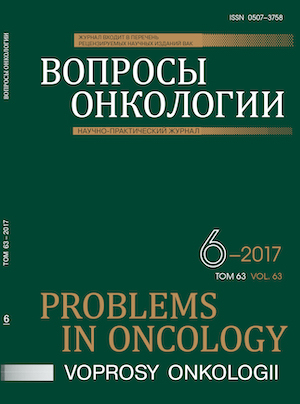Аннотация
Чувствительность цитологического скрининга РШМ, несмотря на используемые технические усовершенствования, остается достаточно низкой. показано, что среди женщин с мазками, расцененными как сомнительные цитологические заключения ASCUS в 5% - 10% случаи, на самом деле, характеризовались тяжелой дисплазией. применение новых молекулярных методов диагностики может повысить эффективность скрининга РШМ за счет повышения точности диагностики степени дисплазии. неопластическая трансформация эпителия шейки матки сопровождается специфическими изменениями профиля экспрессии микроРНК, оценка которых имеет большой диагностический потенциал. В данной работе проведен анализ экспрессии 18 микроРНК. Установлена корреляция экспрессии пяти миРНК (miR-375, miR-20a, miR-196b, miR145 and miR-126) со степенью неоплазии шейки матки, что позволяет рекомендовать их для дальнейшего исследования с целью внедрения в качестве диагностического теста на этапе цитологического скрининга.Библиографические ссылки
Каприн А.Д. Злокачественные новообразования в России в 2015 году (заболеваемость и смертность). - М.: ФГБУ «МНИОИ им. П.А. Герцена» Минздрава России, 2017. - 250 с.
Botezatu A., Goia-Rusanu C.D., Iancu I.V. et al. Quantitative analysis of the relationship between microRNA124a, -34b and -203 gene methylation and cervical oncogenesis // Mol. Med. Rep. - 2011. - Vol. 4. - № 1. - P. 121128.
Castellsague X., Pawlita M., Roura E., Marqal N. Prospective seroepidemiologic study on the role of human papillomavirus and other infections in cervical carcinogenesis: evidence from the cohort // Int. J. Cancer. - 2014. - Vol. 135(2). - P. 440-452.
Di Leva G., Garofalo M., Croce C. M. MicroRNAs in cancer // Annu. Rev. Pathol. - 2014. - Vol. 9. - P. 287-314.
Fang H., Shuang D., Yi Z., Sheng H., Liu Y. Up-regulated microRNA-155 expression is associated with poor prognosis in cervical cancer patients // Biomed Pharmacother. - 2016. - Vol. 83. - P. 64-69.
Han Y., Xu G.X., Lu H. et al. Dysregulation of miRNA-21 and their potential as biomarkers for the diagnosis of cervical cancer // Int. J. Clin. Exp. Pathol. - 2015. - Vol. 8. - № 6. - P. 7131-7139.
Hao M., Zhao W., Zhang L. et al. Low folate levels are associated with methylation-mediated transcriptional repression of miR-203 and miR-375 during cervical carcinogenesis // Oncol. Lett. - 2016. - Vol. 11(6). - P. 3863-3869.
Heejeong Lee, Kyu Rae Kim et al. MicroRNA expression profiling and Notch1 and Notch2 expression in minimal deviation adenocarcinoma of uterine cervix // World J. Surg. Oncol. - 2014. - Vol. 12. - P. 334.
Huang TH., Chu T.Y Repression of miR-126 and upregulation of adrenomedullin in the stromal endothelium by cancer-stromal cross talks confers angiogenesis of cervical cancer // Oncogene. - 2014. - Vol. 33(28). - P. 3636-3647.
Gao D., Zhang Y., Zhu M. et al. miRNA Expression Profiles of HPV-Infected Patients with Cervical Cancer in the Uyghur Population in China // PLoS One. - 2016. - Vol. 11(10).
Gocze K., Gombos K., Kovacs K. et al. MicroRNA expressions in HPV-induced cervical dysplasia and cancer // Anticancer Res. - 2015. - Vol. 35. - № 1. - P. 523-530.
Pedroza-Torres A., Lopez-Urrutia E., Garcia-Castillo V. et al. MicroRNAs in cervical cancer: evidences for a miRNA profile deregulated by HPV and its impact on radioresistance // Molecules. - 2014. - Vol. 19. - № 5. - P. 6263-6281.
Ribeiro J., Marinho-Dias J., Monteiro P. et al. miR-34a and miR-125b Expression in HPV Infection and Cervical Cancer Development // Biomed. Res. Int. - 2015. - Vol. 2015. - P 304584.
Shen Y., Li Y., Ye F. et al. Identification of miR-23a as a novel microRNA normalizer for relative quantification in human uterine cervical tissues // Exp. Mol. Med. - 2011. - Vol. 43(6). - P. 358-366.
Tian Q., Li Y., Wang F. et al. MicroRNA detection in cervical exfoliated cells as a triage for human papillomavirus-positive women // J. Natl. Cancer Inst. - 2014. - Vol. 106. - № 9. - DOI: 10.1093/jnci/dju241
Wang X., Tang S., Le S.Y et al. Aberrant expression of oncogenic and tumor-suppressive microRNAs in cervical cancer is required for cancer cell growth // PLoS One. - 2008. - Vol. 3 (7).
Wang X., Wang H.K., Li Y et al. MicroRNAs are biomarkers of oncogenic human papillomavirus infections // Proc. Natl. Acad. Sci U. S. A. - 2014. - Vol. 111. - № 11. - P. 4262-4267.
Wang L., Chang L., Li Z. et al. miR-99a and -99b inhibit cervical cancer cell proliferation and invasion by targeting mTOR signaling pathway // Med. Oncol. - 2014. - Vol. 31(5). - P. 934.
Wang L., Yu J., Xu J. et al. The analysis of microRNA-34 family expression in human cancer studies comparing cancer tissues with corresponding pericarcinous tissues // Gene. - 2015. - Vol. 554. - № 1. - P. 1-8.
Xin F., Liu P., Ma C-F A circulating serum miRNA panel as early detection biomarkers of cervical intraepithelial neoplasia // Eur. Rev. Med. Pharmacol. Sci. - 2016. - Vol. 20 (23). - P. 4846-4851.
Yang Y, Xie YJ., Xu Q. et al. Down-regulation of miR-1246 in cervical cancer tissues and its clinical significance // Gynecol. Oncol. - 2015. - Vol. 138 (3). - P. 683-688.
Zheng W., Liu Z., Zhang W., Hu X. miR-31 functions as an oncogene in cervical cancer // Arch Gynecol. Obstet. - 2015. - Vol. 292(5). - P. 1083-1089.

Это произведение доступно по лицензии Creative Commons «Attribution-NonCommercial-NoDerivatives» («Атрибуция — Некоммерческое использование — Без производных произведений») 4.0 Всемирная.
© АННМО «Вопросы онкологии», Copyright (c) 2017
